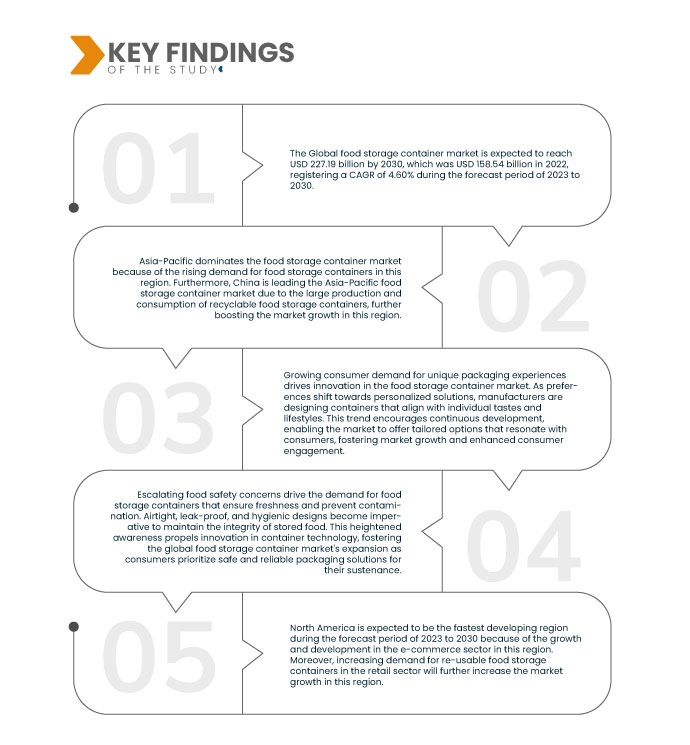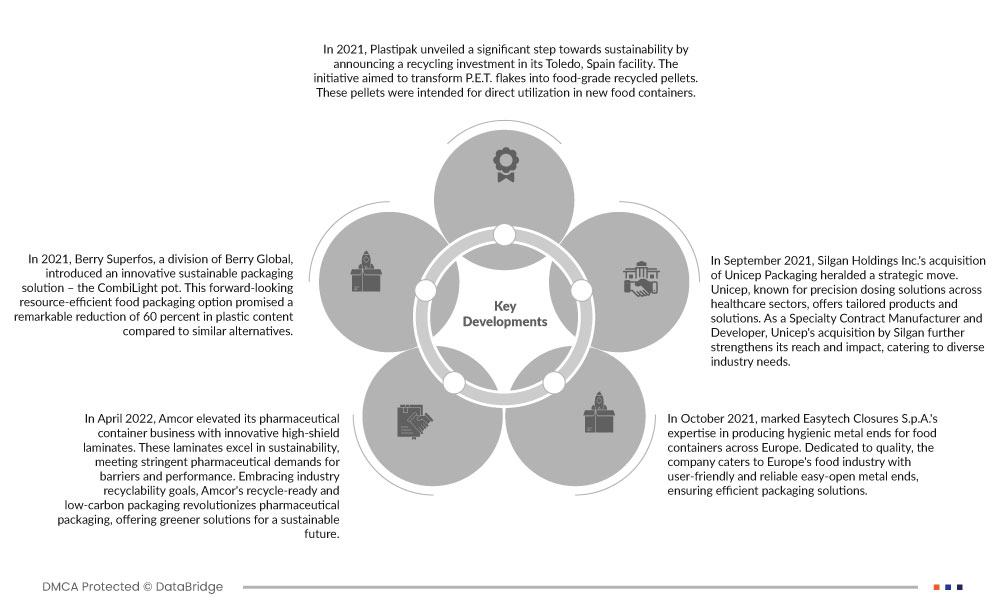지속가능성 문제와 포장과 관련된 환경 영향에 대한 인식이 높아지면서 글로벌 식품 보관 용기 시장은 급속한 성장을 경험하고 있습니다. 이로 인해 소비자들의 선호도가 친환경적인 옵션으로 전환되었습니다. 또한, 제조업체들이 식품 용기의 미적 감각과 혁신적인 디자인을 중시함에 따라 식품 생산자들은 다양하고 창의적인 포장 솔루션을 도입하고 있습니다. 편리한 보관 및 운송에 대한 요구와 맞물려 이러한 추세는 가까운 미래에 시장 성장을 견인할 것으로 예상됩니다.
전체 보고서는 https://www.databridgemarketresearch.com/reports/global-food-storage-container-market 에서 확인하세요.
데이터 브리지 마켓 리서치(Data Bridge Market Research)에 따르면, 글로벌 식품 보관 용기 시장은 2030년까지 2,271억 9천만 달러에 이를 것으로 예상되며, 2022년에는 1,585억 4천만 달러 규모였던 시장 규모는 2023년부터 2030년까지 연평균 4.60% 성장할 것으로 전망됩니다. 신흥 시장의 중산층 증가와 도시화 추세는 포장 및 간편식품에 대한 수요를 증가시키고 있습니다. 이러한 수요 급증은 적합한 식품 보관 솔루션의 필요성을 강조하며 글로벌 식품 보관 용기 시장의 성장을 촉진하고 있습니다.
연구의 주요 결과
식품 및 음료 부문의 끊임없는 확장은 시장 성장률을 견인할 것으로 예상됩니다.
뛰어난 품질과 편의성에 대한 소비자들의 기대가 높아지는 가운데, 식음료 산업의 끊임없는 성장은 효율적인 식품 보관 솔루션에 대한 전 세계적인 수요를 촉진하고 있습니다. 다양한 취향과 라이프스타일을 충족하기 위해 산업이 다각화됨에 따라, 믿을 수 있고 실용적이며 혁신적인 식품 보관 용기에 대한 필요성은 더욱 커지고 있습니다. 산업 성장과 소비자 선호도 간의 역동적인 시너지는 끊임없는 혁신을 촉진하여 글로벌 식품 보관 용기 시장의 탄탄한 성장을 촉진합니다.
보고서 범위 및 시장 세분화
보고서 메트릭
|
세부
|
예측 기간
|
2023년부터 2030년까지
|
기준 연도
|
2022
|
역사적인 해
|
2021 (2015-2020년으로 맞춤 설정 가능)
|
양적 단위
|
매출(10억 달러), 볼륨(단위), 가격(USD)
|
다루는 세그먼트
|
재료(판지, 금속, 유리, 플라스틱 및 기타), 제품(병 및 항아리, 캔, 가방, 컵 및 통, 상자 및 기타), 포장 유형( 경질 포장 , 반경질 포장 및 유연 포장), 응용 분야(곡물 제분 제품, 유제품, 과일 및 채소, 제빵 제품, 육류 제품, 사탕 및 과자 및 기타)
|
포함 국가
|
미국, 캐나다, 멕시코, 브라질, 아르헨티나, 남미 기타 지역, 독일, 프랑스, 이탈리아, 영국, 벨기에, 스페인, 러시아, 터키, 네덜란드, 스위스, 유럽 기타 지역, 일본, 중국, 인도, 한국, 호주 및 뉴질랜드, 싱가포르, 말레이시아, 태국, 인도네시아, 필리핀, 아시아 태평양 기타 지역, 아랍에미리트, 사우디아라비아, 이집트, 이스라엘, 남아프리카 공화국, 중동 및 아프리카 기타 지역
|
시장 참여자 포함
|
Clorox Company(미국), Tupperware(미국), Newell Brands(미국), Amcor plc(스위스), LocknLock Co.(한국), Molded Fiber Glass Company(미국), Prepara(미국), Thermos LLC(미국), Freshware(미국), Oneida(미국), Glasslock(미국), Vremi(미국), Vtopmart(미국), EMSA GmbH(독일), Silgan Containers(미국), Lindar Corp.(미국), Detmold Group(호주), Pactiv LLC(미국), OXO(미국)
|
보고서에서 다루는 데이터 포인트
|
Data Bridge Market Research에서 큐레이팅한 시장 보고서에는 시장 가치, 성장률, 세분화, 지리적 범위, 주요 기업 등 시장 시나리오에 대한 통찰력 외에도 심층적인 전문가 분석, 지리적으로 대표되는 회사별 생산 및 용량, 유통업체 및 파트너의 네트워크 레이아웃, 자세하고 업데이트된 가격 추세 분석, 공급망 및 수요에 대한 부족 분석이 포함됩니다.
|
세그먼트 분석:
식품 보관 용기 시장은 재료, 제품, 포장 유형 및 용도를 기준으로 세분화됩니다.
- 식품 보관 용기 시장은 재료를 기준으로 종이판지, 금속, 유리, 플라스틱 및 기타로 구분됩니다.
- 식품 보관 용기 시장은 제품을 기준으로 병과 항아리, 캔, 봉지, 컵과 통, 상자 및 기타로 구분됩니다.
- 포장 유형을 기준으로 식품 보관 용기 시장은 강성 포장, 반경성 포장, 유연 포장 으로 구분됩니다 .
- 식품 보관 용기 시장은 용도에 따라 곡물 분쇄 제품 , 유제품, 과일 및 채소, 제빵 제품, 육류 제품, 사탕 및 과자 및 기타로 구분됩니다.
주요 플레이어
Data Bridge Market Research는 글로벌 식품 보관 용기 시장의 주요 글로벌 식품 보관 용기 시장 참여자로 The Clorox Company(미국), Tupperware(미국), Newell Brands(미국), Amcor plc(스위스), LocknLock Co.(한국), Molded Fiber Glass Company(미국), Prepara(미국), Thermos LLC(미국)를 다음과 같이 인식합니다.
시장 개발
- 2021년, 플라스티팩(Plastipak)은 스페인 톨레도 공장에 재활용 투자를 발표하며 지속가능성을 향한 중요한 발걸음을 내디뎠습니다. 이 계획은 PET 플레이크를 식품 등급 재활용 펠릿으로 전환하는 것을 목표로 했습니다. 이 펠릿은 새로운 식품 용기에 직접 활용될 예정입니다.
- 2021년, Berry Global의 자회사인 Berry Superfos는 혁신적인 지속 가능한 포장 솔루션인 CombiLight 냄비를 출시했습니다. 이 미래 지향적인 자원 효율적인 식품 포장 옵션은 유사 제품 대비 플라스틱 함량을 60%나 줄이는 놀라운 효과를 약속했습니다.
- 2022년 4월, Amcor는 혁신적인 고차폐 라미네이트를 통해 제약 용기 사업을 강화했습니다. 이 라미네이트는 지속가능성이 뛰어나 제약 업계의 엄격한 장벽 및 성능 요건을 충족합니다. 업계의 재활용성 목표를 충족하는 Amcor의 재활용 가능 저탄소 포장재는 제약 포장에 혁신을 일으키며 지속 가능한 미래를 위한 친환경 솔루션을 제공합니다.
- 2021년 10월, Easytech Closures SpA는 유럽 전역의 식품 용기용 위생적인 금속 캡 생산 전문성을 인정받았습니다. 품질에 중점을 둔 Easytech Closures SpA는 사용자 친화적이고 신뢰할 수 있는 간편 개봉 금속 캡을 통해 유럽 식품 산업에 효율적인 포장 솔루션을 제공합니다.
- 2021년 9월, Silgan Holdings Inc.가 Unicep Packaging을 인수한 것은 전략적 행보의 시작이었습니다. 의료 분야 전반에 걸쳐 정밀 계량 솔루션으로 유명한 Unicep은 맞춤형 제품과 솔루션을 제공합니다. 특수 계약 제조업체이자 개발업체인 Unicep은 Silgan에 인수됨으로써 다양한 업계 요구를 충족하며 사업 영역과 영향력을 더욱 강화하게 되었습니다.
지역 분석
지리적으로, 글로벌 식품 보관 용기 시장 보고서에서 다루는 국가는 미국, 캐나다, 멕시코, 브라질, 아르헨티나, 남미 기타 지역, 독일, 프랑스, 이탈리아, 영국, 벨기에, 스페인, 러시아, 터키, 네덜란드, 스위스, 유럽 기타 지역, 일본, 중국, 인도, 한국, 호주 및 뉴질랜드, 싱가포르, 말레이시아, 태국, 인도네시아, 필리핀, 아시아 태평양 기타 지역, 아랍에미리트, 사우디아라비아, 이집트, 이스라엘, 남아프리카 공화국, 중동 및 아프리카 기타 지역입니다.
Data Bridge Market Research 분석에 따르면:
아시아 태평양 지역은 2023년부터 2030년까지의 예측 기간 동안 글로벌 식품 보관 용기 시장 에서 주도적인 지역입니다.
아시아 태평양 지역이 식품 보관 용기 시장에서 우위를 점하는 것은 해당 지역의 용기 수요 급증에 힘입은 것입니다. 특히 중국은 재활용 식품 보관 솔루션의 활발한 생산 및 소비를 바탕으로 이러한 시장 지배력을 선도하고 있습니다. 이러한 성장세는 국내 시장뿐 아니라 아시아 태평양 지역 전체의 시장 성장에도 기여하고 있습니다.
북미는 2023년부터 2030년까지의 예측 기간 동안 글로벌 식품 보관 용기 시장에서 가장 빠르게 성장하는 지역으로 추산됩니다.
북미는 2023년부터 2030년까지 가장 빠르게 성장하는 지역으로 예상되며, 이는 주로 급성장하는 전자상거래 부문 덕분입니다. 이 지역의 활발한 온라인 상거래 환경은 효율적인 포장을 필요로 하며, 이는 식품 보관 용기에 대한 수요를 촉진합니다. 또한, 소매 부문에서 재사용 가능 용기에 대한 선호도가 증가함에 따라 시장 확장이 가속화되고 있으며, 이는 지속가능성 트렌드의 변화를 반영합니다.
글로벌 식품 보관 용기 시장 보고서에 대한 자세한 내용은 여기를 클릭하세요 - https://www.databridgemarketresearch.com/reports/global-food-storage-container-market












